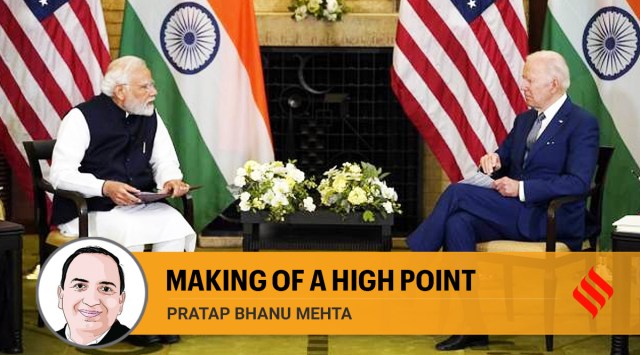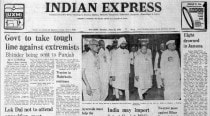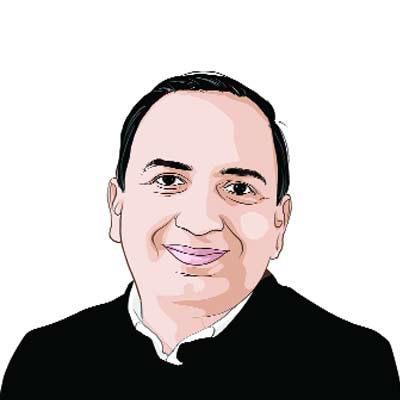Pratap Bhanu Mehta on Modi’s US visit: Making of a high point
Pratap Bhanu Mehta writes: Most striking thing about the current India-US moment is the sheer asymmetry of what the US is offering. It may not last
 Pratap Bhanu Mehta writes: The US is asymmetrically signaling that it wants India to be on its side (PTI)
Pratap Bhanu Mehta writes: The US is asymmetrically signaling that it wants India to be on its side (PTI) The India-US relationship is reaching a new high point. But the significance of Prime Minister Narendra Modi’s trip to the US will be obscured by short-term political framings. There will be the sheer political theatre of the US courting India and the Prime Minister leveraging this moment to shore up his domestic political legitimacy. There will be the disappointment of those who think the Biden Administration is actually going out of its way to give its imprimatur on the state of India’s democracy. But “democracy” was not going to be an issue in this phase of India-US relations.
For all American administrations, democracy has been a geo-strategic tool. Few things provoke more cynicism about democracy than its advocacy by the US government. But more importantly, the prestige of American democracy is at its lowest point in recent memory. There will also be a great deal of rewriting of history, with all the uninformed condescension of posterity. India is overcoming its “historic hesitations”, we will intone, as if serious foreign policy began only in 2014. Indeed, we would do well to remember that India’s current success and its strong bargaining position is built on those “historic hesitations” that kept us independent.
The most striking thing about the current moment is the sheer asymmetry of what the US is offering. It is offering high-end technology and co-production possibilities with a power that is not an ally. It is framing this relationship as a long-term partnership where India becomes important to US supply chains. India, in turn, leverages these relationships to create a manufacturing eco-system. It is doing this despite India’s manifest weaknesses. India’s growth is decent. But even we have scaled back our aspirations down to the 6 per cent range.
Contrary to what we project domestically, India has shown little capability of pushing back China. The situation on the border with China is nowhere near inching back to status quo ante. India’s power projection capabilities have been called out. But the US is going out of the way to bring India into the tent. So much so that even the most vociferous architects of this relationship, like Ashley Tellis, are striking a cautionary note in the US context. So the question is: Why?
The US is being far-sighted in accepting, at least for now, the asymmetry in this relationship. In part, this is a smartly pre-emptive move on the part of the US in two respects. Even at the low point of Indo-US relations, the US recognised that India’s stability is itself a force for the good. The US is already facing a hostile Russia, China and Iran. Even the Middle East, including Saudi Arabia and Israel, is slipping into potentially adversarial territory for the US. Much of Asia, with the possible exception of Singapore, is still hedging. And Europe is diverging from America’s approach to China. The US has not had its way in practically any part of the world for the last couple of decades. Even the Russian economy has proved more resilient than the US hoped. In this context, if India were to even be cool to the US, we are looking at a world order being upended very quickly.
One of the enduring puzzles of international relations is this. If China is really interested in challenging the US, it would have made peace with India. If China were more cautious on support to Pakistan, and less assertive on a border dispute with India that brings China few material gains, it would have made America’s global standing even more vulnerable. Paradoxically, the US investment in India, on this view, is not just that they have a common adversary in China, but that, in the long run, the US will need to ensure India is not closer to any other power.
Which is possibly why India’s low effort and power projection capabilities against China are being ignored. The US’s best investments have been when it has accepted these asymmetrical burdens (think of Europe). Will a Trump-like president be more transactional and short-sighted? The fact that the US is accepting this asymmetry is quite a remarkable moment, more for the US than for India.
The second pre-emptive move is to bring India into the US military industrial complex. Keeping India out of that complex during the Cold War simply pushed it into the hands of US competitors. But the US defence industry will also need the Indian market. It is in US interest that India’s dependence on Russia is reduced. India is a peculiar case in that whatever else one might say of the Russians (or the French), they offer India co-production possibilities. India has very limited resources. It is difficult to see it accepting any deals that cannot be leveraged at least for a significant degree of domestic manufacturing.
The potentially most exciting part of the conversation is the promise of a broad-based technology partnership. But this is also the part that is, at best, a promissory note. The US approach to climate change has never included taxes and finance. It is betting that the Inflation Reduction Act produces innovations that lower the cost of climate-friendly technologies. But India will have to play a key role in the diffusion of these technologies. India is a potential node in the diversification of supply chains. And the US government is going out of its way to signal to the private sector to look at India seriously.
The US is asymmetrically signaling that it wants India to be on its side. The symbolism of the signal is important. But it is a very low cost (in material and financial terms) signal for the US right now to ensure that a major power like India, while it retains its strategic autonomy, does not actively cause more headaches for it in the global order. Like every US administration over the last three decades, this one is also betting on India’s promise — but there is little evidence yet that India’s domestic policies will allow it to redeem the scale of this promise.
Credit to the government that it has read the US’s positioning well. India has, diplomatically, made the most of a fortuitous conjuncture. But equally, it would also be foolish not to recognise how fortuitous this conjuncture is: The conditions that make it possible could vanish as quickly as they appeared.
The writer is contributing editor, The Indian Express








































